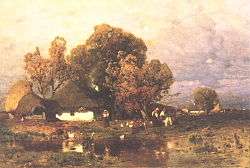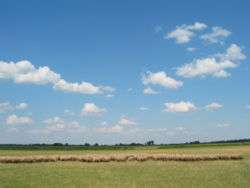Great Hungarian Plain
The Great Hungarian Plain (also known as Alföld or Great Alföld, Hungarian: Alföld, Nagy Alföld)[1][2] is a plain occupying the southern and eastern part of Hungary, some parts of the Eastern Slovak Lowland (Východoslovenská nížina), southwestern Ukraine, the Transcarpathian Lowland (Zakarpats'ka nyzovyna), western Romania (various names), northern Serbia (various names), and eastern Croatia (various names). It is the largest part of the Pannonian Plain.
In Hungarian, the plain is known as Alföld [ˈɒlføld], in Slovak as Veľká dunajská kotlina, in Romanian as Câmpia Tisei or Câmpia de Vest, in Croatian as Panonska nizina, in Serbian as Panonska nizija, and in Ukrainian as Тисо-Дунайська низовина.
Boundaries

Its boundaries are the Carpathians in the north and east, the Transdanubian Mountains and Croatian mountains in the southwest, and approximately the Sava river in the south.
Geography
Plain in Hungary

Its territory is 52,000 km² within Hungary, which includes approximately 56% of the total (93,000 km²). The highest point of the plain is Hoportyó (183 m), and the lowest point is the Tisza River. The terrain ranges from flat to rolling plains.
The most important Hungarian writers inspired by and associated with the plain are Ferenc Móra and Zsigmond Móricz, as well as the poets Sándor Petőfi and Gyula Juhász.
Hungarian scientists born on the plain include Zoltán Bay, physicist; János Irinyi, chemist, inventor of the noiseless match; János Kabay, pharmacologist; Gábor Kátai, physician and pharmacist; and Frigyes Korányi, physician and pulmonologist.
The most important river of the plain is Tisza.
The notable cities and towns with medicinal baths are Berekfürdő, Cserkeszőlő, Gyula, Hajdúszoboszló, Szentes and Szolnok.
Among the cultural festivals and programmes characteristic of the region are the Csángófesztivál (Csángó Festival) in Jászberény, the Cseresznyefesztivál (Sweet Cherry Festival) in Nagykörű, the Gulyásfesztivál (Goulash Festival) in Szolnok, the Hídi Vásár (Bridge Fair) in Hortobágy National Park, the Hunniális at Ópusztaszer, the Szabadtéri Játékok (Open-air Games) in Szeged, the Várjátékok (Castle Games) in Gyula, the Virágkarnevál (Flower Carnival) in Debrecen and the Bajai Halászléfőző Népünnepély (Fisherman's Soup Boiling Festival) in Baja.


The part of the plain located in Hungary comprises the following areas:
- Mezőföld
- Sárrét
- Sárköz
- Drávamellék
- Kiskunság
- Jászság
- Pest Plain
- Heves Plain
- Borsodi-Mezőség
- Bodrogköz
- Tiszahát
- Szatmár Plain
- Maros-Körös köze
- Körös-vidék
- Nagykunság
- Hortobágy National Park
- Hajdúság
- Nyírség
Plain in Serbia
The term is being used in Serbia to denote Hungarian portion of the Pannonian plain.
Pannonian plain in Serbia is mostly divided into 3 large geographical areas: Bačka, Banat and Srem (Syrmia), most of which are located in the Vojvodina province.
Plain in Croatia
The term is rarely used in Croatia, and is usually associated with the geography of Hungary.
Parts of Pannonian Croatia can be considered an extension of Alföld, particularly eastern Slavonia and the connected parts of Syrmia.[3]
Plain in Slovakia
Part of the plain located in Slovakia is known as Eastern Slovak Lowland.
Plain in Ukraine
Part of the plain located in Ukraine is known as Transcarpathian Lowland.
Plain in Romania
In Romania, the plain (Rom. câmp or câmpia, from Lat. campus) includes various regions like Banat and Crişana. Here, its name is Câmpia de Vest (The Western Plain).
See also
Prehistoric culture
During the Prehistoric Era, the Great Hungarian Plain was a place of cultural and technological changes, as well as an important meeting point of cultures of the East and the Western Europe. Therefore, the Great Hungarian Plain is a region of great archaeological importance to major European cultural transitions.
Neolithic
Agriculture began in the Great Hungarian Plain with the Körös Culture, located in present-day Serbia in the Early Neolithic, 6.000-5.500 BC.
In the Middle Neolithic, the Linear Pottery culture stood out over the rest. It was known as Linearbandkeramik (LBK) 5.500 years ago, a culture consisting of two synchronous regional groups:
- Alföld Linear Pottery Culture (ALP)
- Transdanubiana LBK, a variant at west of Hungary who later dispersed towards Central Europe turning into the dominant agricultural culture of Europe.
Locally, it was developed the Lengyel culture in the Late Neolithic 5.000 - 4.500 BC.
Bronze Age
During the Early Bronze Age (2.800 - 1.800 BC), the growing demand for metal ores in Europe resulted in the new pan-European and intercontinental trade networks. In the Early Bronze Age, Cultures of the Great Hungarian Plain, which incorporated technology, differed in the types of settlement in terms of material culture from the other cultures of Bronze Age Near Eastern, Steppe and Central Europe.
Iron Age
In the early phase of the Iron Age (first millennium BC) cultural transitions occurred in the East of the Great Hungarian Plain:
- Population inhabiting the Danube region in Central Europe
- Pre-Scythian populations (Mezőcsát communities of unknown origin) in the East of the Great Hungarian Plain.
The presence of populations and acknowledging the existence of the population flux were studied by the discovery of archaeological remains. By analyzing these remains we noted the relationship between the cultural transitions and the population migration within the Great Hungarian Plain.
Genomic analysis of prehistoric populations
In the last decade, it has become possible to access ancient human genomes through the development of techniques for high-throughput sequencing and it is now an important resource that allows us to test archaeological hypotheses in situ. We may learn new facts about the European Human Prehistory by determining to date complete or partial autosomal genomes.
In the study of Gamba et al., (2014), 19 samples from hunter-gatherers, two full ancient genomes and four partial genomes were chosen from old farmer from Tyrol, Germany and Sweden.Even if we have not investigated yet the temporal dynamics of the entire genome in a defined European region, previous analyzes showed that genomes of hunter-gatherers fell outside the range of the modern European variation, whereas the samples of farmers had an affinity with the southern Europeans, especially the Sardinian population.
Therefore, in this research all the cultural changes was observed in a transect of 5.000 years with complete or partial autosomal genomes. Archaeological remains like dental crowns, ribs, metacarpals, metatarsals and petrous part of the temporal bone, were identified. Archaeological remains belonged to 23 individuals in eastern Hungary in the Great Hungarian Plain.
Endogenous DNA content
In spite of the numerous advantages of the analysis of genome-wide, these data were not routinely accessible due to the low endogenous DNA in the human bone in most of the archaeological contexts.
Endogenous DNA content of the petrous part of the temporal bone, the densest bone in the body of the compared mammals and alternative skeletal elements of the Hungarian skeleton samples are combined through various periods of time (five samples derived from Neolithic individuals, an individual of the Bronze Age and an individual from the Iron Age).
The yields of endogenous DNA of petrous samples in comparison with the other analyzed samples were much higher. Sampling was extended to seven other petrous part of the temporal bone from Hungary and endogenous DNA yields remained exceptionally and consistently high.
Temporal dynamics of genomic affinity
The extent of genomics population in the time dimension is a great development in the field of human evolution, but the low content of endogenous DNA of most bones is an important constraint. To investigate the temporal dynamics of genome genomic libraries, one from the Neolithic Era (5.310 – 5.070 BC) and one from the Bronze Age (1.110-1.270 BC) were sequenced. This allowed us to establish the genomic transect 5.000 years from the early Neolithic (culture Körös) to Iron Age (pre-Scythian regions).
All individuals analyzed are from defined archaeological contexts, that is, from the beginning of agriculture during the Neolithic Era, Körös until the pre-Escitias in the Iron Age and were directly dated by 14C or radiocarbon.
By Procrustes analysis, Single Nucleotide Polymorphisms (SNP) were combined. This analysis changes were detected in the genomic affinities of the ancient genotypes and the cultural changes coinciding with a period of 2800 years of immobility in the Neolithic.
Furthermore, genomic continuity was evaluated against the change in these series of time and how these relate ancient genomes . A summary of autosomal genomic variation two dimensions was generated using the Principal Component Analysis (PCA) and combining the observed genotype data with published sequences of ancient and modern genotypes of individuals in Europe, the Caucasus and the Near East. Based on these analyzes, the samples can be divided into sets that are in different regions of the PCA, being the oldest shows of the Körös population.
The results of these analyzes established the following relationships between populations:
- Neolithic’s Populations: Relationship with current Sardinian population.
- Bronze Age’s Populations: Relationship with current populations of Central Europe, such as the case of the Hungarian population.
- Iron Age’s Populations: Relationship with current populations of Eastern Eurasia.
Imputation of ancient genomes
For this, 1000 baseline data were used by projecting phases Genome were attributed SNP genotypes well characterized on chromosome from 22 individuals from the Neolithic and the Bronze Age.
Therefore, genotypes for each of the genomes were attributed and after the intersection with current data from SNP, a total of 151.407 of diploid loci were found in all samples. These data were used in the analysis of mixtures, which reaffirmed the grouping and temporal changes observed with PCA described above.
Genotypes under selection
Skin pigmentation
In individuals from the Neolithic population, there is a tendency for lighter pigmentation, analyzed through three SNPs pigment, showing specific selective sweeps that facilitate the synthesis of vitamin D.
Eye color and hair pigmentation
Transition towards a clearer pigmentation also seen concerning to the hair. The hair's SNPs were estimated from the forensic system Hirisplex which allows predicted from DNA samples color hair and eyes simultaneously.
- Black / Dark brown in early signs
- Light / Dark Blonde Brown in subsequent individuals
Lactase allele
Within the variation of the human genome, the persistence of lactase allele is one of the strongest selection signals. This was, determined in a European-based maintenance diet of raw milk of the domestic livestock.
It has been determined that this allele is submitted to selection 5500 years ago, possibly in partnership with the Neolithic LBK culture in Central Europe.
The lack of persistence of lactase allele was detected as a source between Central Europe and the Balkans.
References
- ↑ Gábor Gercsák (2002). "Hungarian geographical names in English language publications" (PDF). Studia Cartologica. Eötvös Loránd University. Retrieved 30 April 2011.
- ↑ Gábor Gercsák (2005). "Magyar tájnevek angol fordítása" (PDF). Fasciculi Linguistici / Series Lexicographica (in Hungarian). Eötvös Loránd University. Retrieved 30 April 2011.
- ↑ Heršak, Emil; Nikšić, Boris (September 2007). "Hrvatska etnogeneza: pregled komponentnih etapa i interpretacija (s naglaskom na euroazijske/nomadske sadržaje)" [Croatian Ethnogenesis: A Review of Component Stages and Interpretations (with Emphasis on Eurasian/Nomadic Elements)]. Migration and Ethnic Themes (in Croatian). Zagreb: Institute for Migration and Ethnic Studies. 23 (3): 255. ISSN 1848-9184.
U velikoj mađarskoj nizini Alföld zapadno od Karpata tradicionalno su se smještale euroazijske nomadske skupine, a dio panonske Hrvatske može se smatrati ekstenzijom tog područja, osobito istočna Slavonija i s njome povezani dijelovi Srijema.[5]
Gamba, C; Jones, E. R.; Teasdale, M. D.; McLaughlin, R. L.; Gonzalez-Fortes, G.; Mattiangeli, V.; Domboróczki, L.; Kövári, I.; Pap, I.; Anders, A.; Whittle, A.; Dani, J.; Raczky, P.; Higham, T. F. G.; Hofreiter, M.; Bradley, D. G.; Pinhasi, R. (2014). Genome flux and stasis in a five millennium transect of European prehistory. Nature communications. 5:5257 DOI: 10.1038/ncomms6257
External links
| Wikimedia Commons has media related to Great Hungarian Plain. |
 Great Hungarian Plain travel guide from Wikivoyage
Great Hungarian Plain travel guide from Wikivoyage- Körös Regional Archaeological Project: Neolithic and Copper Age archaeology in the Great Hungarian Plain
Coordinates: 47°00′N 20°30′E / 47.000°N 20.500°E
